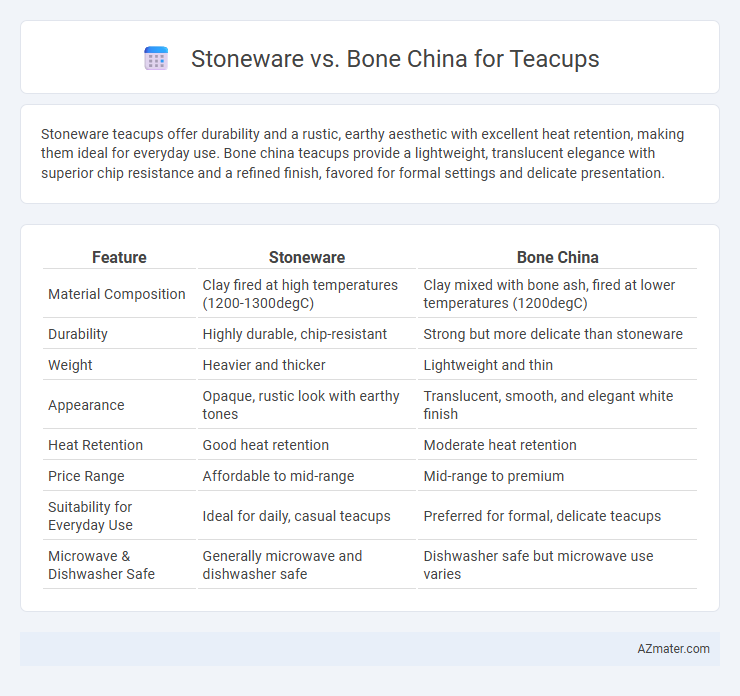Stoneware teacups offer durability and a rustic, earthy aesthetic with excellent heat retention, making them ideal for everyday use. Bone china teacups provide a lightweight, translucent elegance with superior chip resistance and a refined finish, favored for formal settings and delicate presentation.
Table of Comparison
| Feature | Stoneware | Bone China |
|---|---|---|
| Material Composition | Clay fired at high temperatures (1200-1300degC) | Clay mixed with bone ash, fired at lower temperatures (1200degC) |
| Durability | Highly durable, chip-resistant | Strong but more delicate than stoneware |
| Weight | Heavier and thicker | Lightweight and thin |
| Appearance | Opaque, rustic look with earthy tones | Translucent, smooth, and elegant white finish |
| Heat Retention | Good heat retention | Moderate heat retention |
| Price Range | Affordable to mid-range | Mid-range to premium |
| Suitability for Everyday Use | Ideal for daily, casual teacups | Preferred for formal, delicate teacups |
| Microwave & Dishwasher Safe | Generally microwave and dishwasher safe | Dishwasher safe but microwave use varies |
Introduction to Stoneware and Bone China
Stoneware teacups are crafted from dense, non-porous clay fired at high temperatures, making them durable and chip-resistant with a rustic, earthy appearance. Bone china teacups consist of refined clay combined with bone ash, fired at lower temperatures, resulting in a lightweight, translucent, and highly elegant finish. Both materials offer distinct tactile experiences and varying degrees of heat retention, catering to different aesthetic preferences and functional needs in tea drinking.
Material Composition: Key Differences
Stoneware is made from dense clay fired at high temperatures, resulting in a durable, non-porous material with a slightly coarse texture ideal for everyday teacups. Bone china contains bone ash alongside clay and feldspar, creating a lightweight, translucent, and highly durable material prized for its delicate appearance and chip resistance. The high calcium phosphate content in bone china contributes to its whiteness and strength, differentiating it significantly from the more rustic and sturdy stoneware composition.
Durability and Strength Comparison
Stoneware teacups exhibit superior durability due to their dense, non-porous composition, resisting chipping and cracking under everyday use. Bone china, while thinner and more delicate, combines high strength with lightweight elegance, offering remarkable resilience through its bone ash content. Both materials provide robust options, with stoneware excelling in ruggedness and bone china balancing strength with refined aesthetics.
Aesthetic Appeal and Design Options
Stoneware teacups showcase a rustic, earthy aesthetic with natural textures and muted tones, reflecting traditional craftsmanship ideal for casual or farmhouse-style settings. Bone china teacups offer a delicate, translucent quality with fine detailing and intricate patterns, delivering an elegant and refined look perfect for formal occasions. Design options in stoneware tend to emphasize organic shapes and matte finishes, while bone china allows for elaborate decorations and glossy surfaces that highlight its lightweight, fragile nature.
Thermal Properties and Heat Retention
Stoneware teacups offer excellent heat retention due to their thick, dense ceramic composition, maintaining tea temperature longer and providing a warmer drinking experience. Bone china, while thinner and more delicate, has lower thermal mass, causing tea to cool more quickly but offering a refined aesthetic and lighter feel. For those prioritizing thermal properties, stoneware is superior in keeping beverages hot, whereas bone china excels in elegance and lightness.
Weight and Handling Comfort
Stoneware teacups are generally heavier, offering a sturdy feel that some users find comforting and secure, while bone china teacups are notably lighter, enhancing ease of handling and reducing wrist fatigue during extended use. The denser composition of stoneware provides excellent heat retention, but its weight can be cumbersome for delicate sipping, whereas bone china's lightweight and thin walls promote a more refined drinking experience with a comfortable grip. Balancing comfort and practicality depends on personal preferences for weight tolerance and tactile sensation in everyday tea service.
Price Range and Affordability
Stoneware teacups generally fall in a more affordable price range, typically between $10 and $30 per piece, making them ideal for everyday use without compromising durability. Bone china teacups, known for their delicate appearance and high-quality finish, usually cost between $30 and $100 or more, reflecting their premium craftsmanship. The higher price of bone china is often justified by its lightweight feel and translucency, while stoneware offers budget-friendly options with robust construction.
Maintenance and Care Instructions
Stoneware teacups require gentle handwashing with mild detergent to prevent glaze chipping and should be dried thoroughly to avoid moisture retention that can cause odor or mold. Bone china teacups are more delicate and often dishwasher safe but benefit from handwashing to maintain their translucent finish and gold or platinum trim. Both materials should be stored carefully to avoid scratches and sudden temperature changes that can lead to cracking or crazing.
Environmental Impact and Sustainability
Stoneware teacups generally have a lower environmental impact due to the use of natural clay fired at high temperatures, which requires less energy-intensive processes compared to bone china that contains bone ash and undergoes more complex manufacturing. Bone china production involves sourcing animal bone, raising ethical and sustainability concerns related to animal agriculture, while stoneware's materials are more abundant and less resource-heavy. Stoneware teacups also tend to be more durable and easier to recycle, making them a more sustainable choice for eco-conscious consumers.
Which is Best for Teacups: Final Verdict
Bone china teacups are prized for their delicate translucency, lightweight feel, and superior strength despite their thin walls, making them ideal for elegant tea experiences. Stoneware teacups offer robust durability, heat retention, and a rustic aesthetic, perfect for everyday use and casual settings. The best choice depends on preference: bone china suits formal occasions with its refined elegance, while stoneware excels in practicality and warmth for regular tea drinking.

Infographic: Stoneware vs Bone china for Teacup
 azmater.com
azmater.com